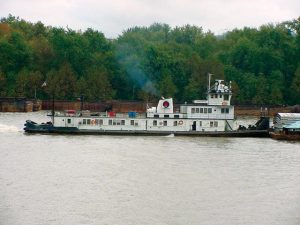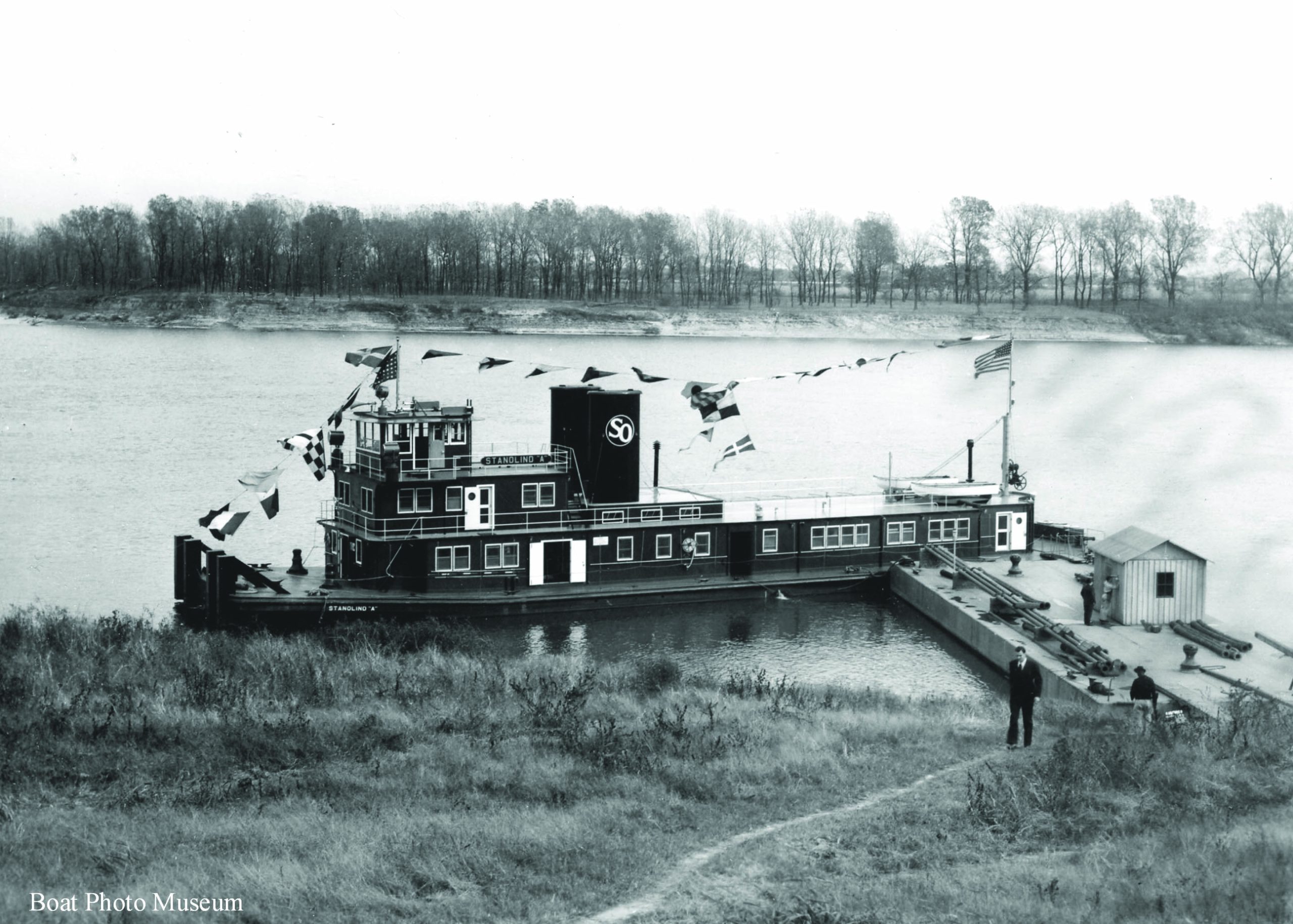In 1911, the U.S. Supreme Court judged Standard Oil Company to be a monopoly and ordered it to be broken up into 34 separate companies. One of these was the Standard Oil Company of Indiana, which was chartered in Indiana but had main offices in Chicago. In 1925, this growing entity merged with the American Oil Company but continued to be known as Standard of Indiana. In 1940, the company had a new towboat built.
The contract for the new vessel went to the Manitowoc Shipbuilding Company, Manitowoc, Wis. The firm began in 1902 as the Manitowoc Dry Dock Company on a site that had been Burger & Burger dating back to 1868. In 1910, the firm’s name became Manitowoc Shipbuilding and Dry Dock Company until 1916, when it was shortened to Manitowoc Shipbuilding Company, or simply Manitowoc. Originally building small scows, barges and tugs, Manitowoc in the 1920s began building larger craft, including small ships and ferries. In 1926, the company turned out the 3,000-ton railroad ferry Manitowoc for the Wabash Railroad.

In 1939, Manitowoc built the 600 hp. towboat Edw. W. Renwick for Marine Transit Company. This 95- by 25-foot boat, built especially for the Illinois River, had a retractable pilothouse and was much-touted in The Waterways Journal. This may have been what attracted the attention of Standard to contract with Manitowoc. Whatever the reason, the hull of the new vessel was launched on August 27, 1940, and christened the Stanolind A by “Miss Marion Hannah.” One can surmise that the “Stanolind” was for Standard Oil of Indiana and the “A” was for American Oil.
The Stanolind A came out in October 1940 and had a steel hull that was 144 feet by 35 feet. The vessel was powered by two 600 hp. Busch-Sulzer direct reversing engines turning the 76-inch propellers. It had a full main cabin that housed quarters for the engineers forward of the engine room. Deck crew quarters, the galley and dining rooms were aft of the engine room. A shorter upper cabin had quarters for the captain and pilot, as well as a guest room, lounge and office.
Above this upper cabin was a squarish pilothouse, and behind the upper cabin were two large steamboat style smokestacks. As with some of the other Standard companies’ colors, the cabins and pilothouse of the Stanolind A were painted a deep red color.
The new boat arrived at what was to be its home port of Evansville, Ind. on November 3, 1940, decked out with flags and pennants. Capt. Charles E. Reinhardt was master and J.R. Halterman was chief engineer. Following ceremonies in Evansville, it went to work delivering petroleum products to terminals on the Ohio and Mississippi rivers. The Stanolind A would eventually extend the runs to the Missouri River as well.
In 1960, the boat was repowered at St. Louis Ship, where the original Busch-Sulzer engines were replaced with a pair of GM (Cleveland) 278A engines. It was then rated 3,200 hp. The two large stacks were removed at this time, with two stacks of a more streamlined design installed in their place.
By 1961, American Oil Company, a division of Standard of Indiana, owned the Stanolind A, and the boat was renamed Amoco Missouri. By 1973, Amoco Oil Company, Wood River, Ill., owned the boat. In 1985, it was again repowered, this time with a pair of GM 16-645E2 engines totaling 3,600 hp. Also in 1985, Standard of Indiana officially became the Amoco Corporation. In 1987, the Amoco Missouri was renamed the mv. Missouri River. At some point, the upper cabin and pilothouse were painted white, as were the stacks, which had been black.
In early 1990, the Missouri River was extensively refurbished and dressed up in honor of its 50th anniversary. The boat was really a beauty inside, with many brass appurtenances, including the engine room handrails. The interior was trimmed in oak, and there were two oak roll-top desks on board. Somewhat surprisingly, the boat was offered for sale later that year. Madison Coal & Supply Company, Charleston, W.Va., became the new owner in October 1990.
Capt. Nelson Jones later related to this writer that when the crew picked the boat up at Wood River, he found a very touching letter that had been left by the former engineer. The letter detailed how long the man had worked aboard the vessel, how it had helped raise his family, and that he hoped the new crew would take care of it. Madison Coal worked the boat for many different companies on the Ohio River until October 1993 when it was sold to Tolen Marine Inc., Paducah, Ky., which renamed it the Charles Duncan.
In July 1997, McGinnis Inc., South Point, Ohio, acquired the floating stock of Tolen Marine. The boats were placed under Excell Marine Corporation of Cincinnati, Ohio, and the Charles Duncan was renamed River Falcon. In 2004, the boat was sold to Argentina and renamed Cavalier VI.
————
Featured photo caption: The new Stanolind A at Evansville, Ind., on November 3, 1940. (From the Dan Owen Boat Photo Museum collection)



